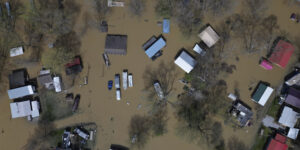Property and casualty reinsurers have displayed underwriting discipline during this year’s renewals, continuing with rate corrections that began several years ago, despite the pressures of abundant capacity. Prices continued to harden during the first half of 2021 – albeit with slightly less momentum than last year – in a trend that will likely continue into the January 2022 renewal season.
These were some of the themes conveyed by two of Guy Carpenter’s property and casualty reinsurance specialists – Sebastian Cook and Chris Ross – who spoke during a media briefing about the state of the property and casualty reinsurance market.
“While reinsurers have an appetite to grow, underwriters largely maintained underwriting discipline and deployed capacity when pricing was deemed adequate,” said Cook, who is managing director and head of European Broking Solutions and London, Europe, for Guy Carpenter.

“On average, sought after upper layers experienced increased market interest, counterbalanced by the harder-market conditions for lower layers, which equated to moderate increases for programs overall,” he said.
Cook noted that U.S. property catastrophe rate-on-line index increased by 6% for renewals from January through to July of this year, which was approximately half of the increase experienced over the same period in 2020. “The increase in Asia, meanwhile, was approximately 5%.”
Overall, rate-on-line levels were affected by several factors, including upward shifts in retentions – particularly for loss affected programs – as well as additional limits purchased on the top end of programs and increased pricing, Cook said.
“More broadly, the concerns about exposure from secondary perils and climate change were offset by abundant capacity and the effect of compounding rate increases and strong appetite for growth,” he added.
Cook acknowledged that capacity levels are being driven upward by capital raises from new market entrants and existing reinsurers, the impact of recent years’ rates increases on reinsurance portfolios and the catastrophe bond market – all creating additional competition that could put pressure on rates.
“All of these factors will hold true as we move forward. However, we are early in the loss estimation process with [Hurricane] Ida and there is remaining runway left for the year,” he said, referring to what remains of the 2021 Atlantic hurricane season.
Casualty Reinsurance

Discussing trends in the casualty market, Chris Ross, a managing director at Carpenter, said the period of market correction began in 2017 when rates hardened significantly. Over the last four years, cumulative rate increases were achieved across commercial auto, general liability, umbrella, and financial lines, he said, noting that financial lines have risen nearly 80% over that time period, while umbrella is up nearly 60%.
Commercial auto began its correction even earlier – in 2011, Ross said.
Strong Position Going Forward
“As we look across the key casualty lines of business today, we clearly see an insurance market that has corrected itself. Insurers and reinsurers are now positioning themselves to capitalize on what we believe will be a casualty market that generates meaningful margins for both insurers and reinsurers,” Ross said.
The casualty market has hardened significantly, which “puts the overall market in a strong position going into the fall renewal season,” he said.
However, hardening rates were only part of the story of the reinsurance casualty market’s correction. Ross explained that carriers implemented other significant changes to counter the dynamic of social inflation, which include capacity reductions, increased insurer retentions, reducing exposure to loss drivers and risk management.
Capacity Reductions
“A clear tool to control loss severity is to reduce the capacity offered, and the insurance industry has done that, particularly in excess casualty and financial lines,” he said. “In excess casualty, for example, it is estimated that capacity reduced by nearly 35%.”
Coupled with hardening rates, “overall portfolio rate-on-line has improved markedly, particularly in high excess layers,” Ross added. “Simply put, carriers are getting more premium per exposure unit now than they have in the past several years.”
Insurer Retentions
Another step the reinsurance casualty market took in the correction was increasing insurer retentions. “For example, as auto loss severity has increased, so too are retentions for lead umbrella, which in some cases are now $2 million or greater.”
Reducing Exposure
Insurers and reinsurers also adjusted, or lowered, their underwriting appetite, which played a role in the casualty correction process, he indicated.
Reducing exposure to loss drivers, such as opioids, communicable diseases, abuse and molestation and brain injury, has been at the forefront of carrier underwriting strategies for the past few years, according to Ross.
Risk Management
And last but not least, Ross cited risk management as an essential tool in the process to push the casualty market back into profit.
“Insurers are working closely with their customers to reduce exposure via risk management services to improve their exposure profiles,” he said. Examples include the numerous vendors within the cyber industry that help carriers assess insured security protocols.
“The combined impact of all these actions has created a positive momentum for the second half of 2021 into 2022,” he affirmed. “But concerns remain, and these concerns all point to continued market discipline for rate increases and for additional focus on underwriting strategies implemented to ensure continued profitability in 2022 and beyond.”





















 The Workplace Is Changing; So Are the Risks for Employment Discrimination Claims
The Workplace Is Changing; So Are the Risks for Employment Discrimination Claims  Future of Auto Insurance: OEM-Insurer Ties Could Boost Profits, Loyalty
Future of Auto Insurance: OEM-Insurer Ties Could Boost Profits, Loyalty  Trump’s Auto Tariffs to Cover Hundreds of Billions of Dollars of Vehicle, Parts Imports
Trump’s Auto Tariffs to Cover Hundreds of Billions of Dollars of Vehicle, Parts Imports  Contractors Insurance Alert: Construction Defect Lawsuits Rising
Contractors Insurance Alert: Construction Defect Lawsuits Rising 



